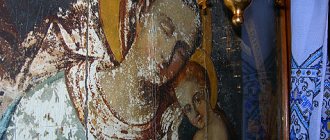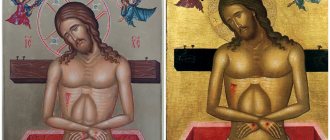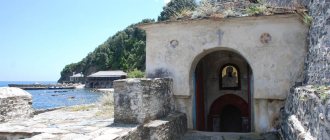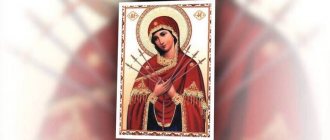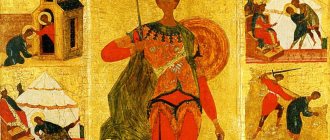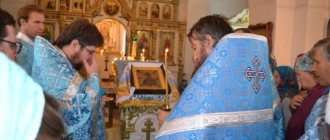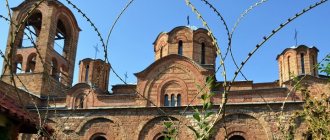The first Christians argued for a long time about whether it was even possible to depict Jesus Christ. Opponents said that the Old Testament forbids the depiction of God. Supporters argued that since the Lord came into the human world in the form of Christ, this prohibition can be considered obsolete. The controversy was so strong that a period of persecution of icons began. But in the end, the icons of Christ the Savior were accepted by the official church.
About the author About the book
The iconography of Christ is not as diverse as, for example, the Virgin Mary. Perhaps this reflects some national characteristics, because in other countries there is generally no such strong veneration of icons. It is probably easier for people to perceive God, knowing that He, too, was once a child in the arms of His Mother.
Symbol and meaning of icons
Since ancient times, believers began to depict God, Saints and the Mother of God. Over time, the church took control of this art and established certain rules and boundaries that had to be followed in the painting. An icon is a kind of mediator between the spiritual divine world and man. Thanks to the holy image, any prayer will ascend to heaven much faster.
The icons of the Orthodox Church are full of various metaphors and associations, each element and each detail has its own hidden, but quite significant meaning. Any image carries a kind of code that reveals the essence of the church, man and faith. For example, the cross is martyrdom, the pointing finger is God’s providence, and the Saint with a spear is victory over evil. In addition, on some ancient icons you can see vines and grapes - a sign of the church.
The symbolic language of icon painting covers not only the gestures and positions of saints. It determines the composition itself, the image technique and even the colors. However, all this is subject to individual church canons. This was done in order to eliminate dual meaning and protect believers from the manifestation of heresy.
Description of the shrine
In the center of the icon there is the face of Jesus Christ, expressing high spirituality, peace and harmony. A halo with a completed form is visible above His head. The image of one face, without shoulders and the rest of the body, symbolizes internal strength, the predominance of the spiritual over the material.
The Savior is drawn in a portrait manner, looking straight into the eyes of everyone who appears before His gaze. The design of the picture is quite simple, without frills or depicting any events. Sometimes on copies of the original you can see floating angels holding the edges of the board.
The Savior Not Made by Hands carries the basic Christian idea: the path to the truth and the Kingdom of God lies through the person of Jesus Christ. The prayer created by this image is like a face-to-face conversation with the Savior of all mankind. While at a shrine, a person should not pay attention to minor details, giving importance only to being alone with the Lord.
The history of the appearance of the first miraculous icons
Healing and helping images, according to church leaders, take their power from God's grace. The Orthodox Church recognizes many miraculous icons, about 1000 to be exact. These are mainly images of Christ and the Virgin Mary.
Many legends say that the first miraculous image is of the cloth with which Jesus wiped his face, and an imprint remained on it. It is also called Mandylion. Initially, the ancient Edessa king Abgar was healed from it. He was sick with leprosy.
One of the first mentions of miraculous icons is also the myrrh-streaming of the Pisidian Icon in the 6th century. Then oil flowed from the hand of the depicted Mother of God. This phenomenon was confirmed at the VII Ecumenical Council.
Christ the Great Bishop
On icons of this type, the Savior is represented in royal or priestly clothing, decorated with gold, and wearing a crown in the form of either a crown or a tiara. This iconographic type is of Western origin and entered Russian iconography only at the end of the 17th century. The image has an apocalyptic interpretation; here the icon painters tried to capture the appearance of the Lord Jesus Christ as it is written in the book of Revelation of John the Theologian: the one sitting on it is called Faithful and True, Who righteously judges and wages war (Rev. 19:11).
The most famous miraculous images of the world
History knows many sacred images that have helped and still heal many human ailments - both mental and physical. At the same time, some Orthodox icons heal infertility, others help in marriage and love, others fulfill wishes, etc. Therefore, queues of believers line up for them, thirsting for specific help. And there are also icons that almost all Orthodox Christians strive to see:
- Icon of St. Nicholas the Wonderworker. Those who are almost desperate turn to this image. And he fulfills any request or prayer that comes from a pure heart. In addition, the Saint is the patron of sailors and travelers.
- Kazan Icon of the Mother of God. One of the most famous images of the Virgin Mary. In modern history, this icon is famous for the fact that during the Great Patriotic War it protected our soldiers and ordinary residents in besieged Leningrad. They say that this image helps many believers in trouble.
- Vladimir Icon of the Mother of God. This is one of the oldest and most revered holy images in Rus', one that should be in every Orthodox family. It heals the body and soul and also protects from evil.
Miraculous icons, as a rule, are accompanied by some signs or significant events. They come to the rescue when believers especially require intercession.
The fate of the iconographic image
Subsequently, Edessa was visited by the apostles Thomas and Thaddeus, who converted the local residents to Christianity. The miraculous image of Jesus Christ was placed above the city gates. Everyone passing through them had to give praise to Jesus Christ. After some time, Christians were persecuted by the authorities. To save the icon, it had to be walled up in the fortress wall. There it remained intact until 545.
Edessa was besieged by the Persian king. The Mother of God appeared to Bishop Eulavius in a dream and indicated the place in the wall where the image was kept. The Savior not made by hands was found, but at the same time another image of Jesus Christ was discovered on the brickwork. After the religious procession was carried out with the icon, the Persians retreated and the city was liberated.
After the conquest of Edessa by the Ottomans in 944, the Savior Not Made by Hands was transferred to Constantinople to the Temple of the Wisdom of God. In honor of the transfer of the image of the Savior to Constantinople, the Church established a holiday, which is celebrated on August 16 (29). Unfortunately, the image was lost and its further fate is unknown. According to one assumption, the Savior Not Made by Hands was kidnapped in 1204 by the crusaders who headed to Venice. But the ship sank in the Sea of Marmara along with the lining.
How icons are recognized as miraculous
Many have heard about the healing properties of one or another divine image. There are also scientifically proven facts of the flow of myrrh and the fragrance of images. However, not every such case is recognized by the official church as miraculous. Over the course of many centuries, Orthodoxy has developed certain rules and canons according to which icons are recognized as miraculous.
Peter I can be considered a pioneer in Rus' in this matter. It was he who issued a number of specific decrees, thanks to which miraculous icons were removed from private homes and were to be kept exclusively in churches. Therefore, subsequently it was church images that received greater chances for recognition.
In addition, in pre-revolutionary, and even modern, Russia, to assess the authenticity of a miracle, Orthodox icons (photo or original) were placed in a special altar. There they were sealed, and in the presence of several witnesses, one of whom must necessarily be in the priesthood, they were checked.
Icon of the Savior
This image is basic in Orthodoxy. Images of Christ have been present in all homes, regardless of income, since ancient times in Rus'. As a rule, the icon of the Savior is made strictly according to generally accepted church canons. This image gives people comfort and faith. Its main elements:
- A halo with an inscribed cross and three Greek letters that represent the expression: “I am who I am.”
- Purple chiton (chasuble). Symbolizes the human nature of the Savior.
- Blue himation (outerwear). Reminiscent of the divine origin of Jesus.
As a rule, now you can find only two types of images of Christ: in the form of an ordinary person or baby, and also in the form of the King of Kings. The icon of Christ the Savior is always located on the central dome of any Orthodox church, because this is considered the most honorable place.
There are several iconographic types of this icon in the main church canons.
Easter iconography
People visiting the temple during the celebration of the Holy Resurrection of Christ often have a question. Why can the Easter icon in different churches differ significantly in its plot and writing?
In some cases, you can see an icon depicting the Savior emerging from the grave cave. In other churches, a completely different story is presented: Jesus Christ leads people out of hell, starting with Adam and Eve. Moreover, both icons are considered “correct” Easter icons. This sometimes causes bewilderment even among believers and people who have been churchgoers for a long time. After all, usually the plot of the holiday on icons does not differ, even with natural differences in the era of writing and different icon painters.
The fact is that Easter is an exception and has two iconographic types at once.
First type
Some of the first examples of Easter iconography are Byzantine frescoes and mosaics. They most often depict the plot set out in the apocryphal “Gospel of Nicodemus”, which was not included in the Bible:
According to Church Tradition, the Savior, after His bodily death, descended into hell to save the souls of dead people. After the fall of Adam and Eve, none of the people, regardless of their lifestyle and holiness, went to heaven. Their souls languished in hell, awaiting the coming of the Messiah - the Savior. But the Lord, through his suffering on the cross, gives people hope for salvation. This great moment in the history of mankind is depicted on Byzantine Easter icons.
This iconographic type of icons is built according to certain principles:
— The Savior occupies a central place on the icon and around Him are depicted several circles from which rays of light emanate. This is a symbol of His greatness and divine dignity. After all, even in the underworld, Jesus Christ remained God.
— In his hands Christ holds the symbol of His suffering - the cross.
— The edges of the snow-white robe float in the air and resemble the wings of a cherub. This indicates how Jesus Christ rises from hell.
- Under the feet of the Savior there is depicted pitch darkness - an abyss. On some icons, an anthropomorphic figure of Satan or demons peeks out of the darkness.
— The background on icons is usually gold, yellow, orange or sand. These colors symbolize the eternal glory of Jesus Christ.
Popular articles Steel pipe ring
— The Savior is the first to lead Adam and Eve out of hell. They are usually depicted rising from their knees. This is a symbol of exit, rise from a sinful state that precedes salvation.
Second type
Second iconographic type: The Savior emerging from the tomb. Appeared in Europe. Angels may be depicted on either side of Jesus Christ. Sometimes, instead of a cave, a sarcophagus with an open lid is depicted. This icon appeared in Europe, and in Russia it has been widespread since the 17th – 19th centuries. As a subject, it is simple and familiar to the perception of believers.
At the same time, the icon contains some inconsistencies with the dogmatic tradition of the Church. The main discrepancy is that for the Savior to leave the cave it was not necessary to roll away the stone from the entrance to the tomb. After all, the body of Jesus Christ after the Resurrection has no external barriers. According to legend, guards guarded an empty cave. The angels rolled away the stone early in the morning to show that the tomb was empty and Christ had risen.
It is also known from the Gospel narrative that the angels during the Resurrection of Jesus Christ were in the cave, and not outside. Roman soldiers, who are sometimes present on the icon, are depicted sleeping, which is also not true. In the Roman Empire there was the strictest discipline; sleeping while on guard was punishable by death. But despite these inaccuracies, the second type of iconographic depiction of Easter is common among holiday icons.
Savior Not Made by Hands
This shrine is considered the very first in the world.
History tells that the Icon of the Savior has two legends about its origin. One of them tells about the time of Christ’s life in Osroene. The local king Abgar V suffered for a long time from the terrible “black leprosy.” Suddenly he heard about an extraordinary man-miracle worker who visited his city. The king sent his painter Ananias to Jesus with a request to heal him. However, the artist still could not approach the Son of God - he was surrounded by a crowd of believers and admirers. Desperate, he decided to sketch Christ, but he could not depict his face. Finally, the Savior himself invited him to his place. To reward the painter, he asked to bring water, washed himself with it and dried himself with a brush. Miraculously, the water turned into paint, and the image of Christ appeared on the canvas. Having received the ubrus, King Avgar was healed and got rid of the ancient idols. Another legend says that the holy image appeared on the handkerchief with which the Savior wiped his face before Calvary during his prayer. Only after the Ascension was this gift given to Ananias.
Prayer 1 to the Lord Jesus Christ
O Master, Lord Jesus Christ, Son of God! Much of Your goodness, for our sake and for our salvation, man was clothed in the flesh and crucified and buried, and with Your Blood renewing our corrupted nature, accept my repentance of sins and hear my words: I have sinned, Lord, in heaven and before You, in word, in deed , soul and body, and the thoughts of my mind, I transgressed Thy commandments, did not listen to Thy commandment, angered Thy Goodness, my God, but as Thy creation exists, I do not despair of salvation, but boldly come to Thy immeasurable Goodness and pray to You: Lord! in repentance, give me a contrite heart and accept me as I pray and give me a good thought, give me the thought of confessing my sins, give me tears of compunction, Lord, let me, by Thy grace, make a good beginning. Have mercy on me, O God, have mercy on me, the fallen one, and remember me, Thy sinful servant, in Thy Kingdom, now and ever and unto ages of ages. Amen.
Savior Almighty
This is one of the fundamental images of Christ in icon painting. It is designed to show a saving, generous and creative God who holds the whole vast world in his hand. Here he is depicted with a blessing right hand and the Gospel. At the same time, the icon of the Savior shows all the boundless kindness and compassion of God.
This image in iconography began to take shape in the 6th century. At this time, almost all holy images were created in Constantinople. That is why the face and robes of Christ took on the uniform form that we now see in the church.
In Rus', the painting appeared around the 11th century. According to legend, the Savior Pantocrator was considered a prayer icon for Russian princes. It was even placed near the tombs of the Yaroslavl rulers Vasily and Constantine.
Savior on the throne
In this image, the Lord is depicted on the throne in full height. Here he is shown not only as the ruler of the whole world, but also as the only judge. His right hand is also raised in blessing, and his left holds the open Gospel. The throne symbolizes the vast Universe and defines the royal glory and power of the Lord.
However, this image is not the only one. There is another Orthodox icon - the icon of the Savior on the throne, where with his right hand he points to the Gospel. This is how the Lord determines the priority and primacy of sacred church power over secular power. There is a well-known legend that tells about a certain Byzantine emperor Manuel I Komnenos. He independently painted the icon of the Savior on the throne, but he quarreled with one Greek priest and decided to punish him for his disagreement. At night, Manuel had a dream in which God was punishing him for interfering in church affairs. Waking up, the emperor discovered numerous wounds on his body. And, looking at the icon, he saw that the Savior had changed the position of his hand. Now he pointed to the lines of the open Gospel. It is known that this icon was called “Manuel the Savior”, or “Golden Robe of the Savior” (for its rich gilded frame).
Savior is in power
This is one of the most symbolic images of the Lord. This icon of Christ the Savior has not yet been fully solved and is interpreted in different ways. Here the Almighty sits at full height on the throne. In his hands is the open Gospel. And the most remarkable thing is that he is always depicted against the background of a red square with slightly elongated ends. The square here symbolizes the Earth. In addition, at its ends there are depicted an angel, a lion, an eagle and a calf. It is generally accepted that these are symbolic images of the faithful evangelists - Matthew, Mark, John and Luke. They seem to spread the teachings of Christ throughout the world.
On top of this red square is a blue oval. This is our spiritual world. It depicts angels, symbolizing all the powers of heaven. A red diamond is again drawn on top of this oval. It defines the world invisible to man.
There is a belief that in this image Jesus will appear at the end of time, at the Last Judgment.
Gospel narrative
All four evangelists narrate about the crucifixion of Jesus Christ, and each provides his own details:
| Gospel | Description |
| From Matthew (Matt. 27:33-38) | And, having come to a place called Golgotha, which means: Place of the Skull, they gave Him vinegar mixed with gall to drink; and, having tasted it, did not want to drink. Those who crucified Him divided His garments, casting lots; and, sitting, they guarded Him there; and they placed an inscription over His head, signifying His guilt: This is Jesus, the King of the Jews. Then two thieves were crucified with Him: one on the right side, and the other on the left. |
| From Mark (Mark 15:22-27) | And they brought Him to the place of Golgotha, which means: Place of Execution. And they gave Him wine and myrrh to drink; but He did not accept. Those who crucified Him divided His garments, casting lots as to who should take what. It was the third hour, and they crucified Him. And the inscription of His guilt was: King of the Jews. Two thieves were crucified with Him, one on His right and the other on His left. And the word of Scripture was fulfilled: he was numbered among the evildoers. Those passing by cursed Him, nodding their heads and saying: Eh! destroying the temple, and building in three days! save yourself and come down from the cross. |
| From Luke (Luke 23:33-43) | And when they came to a place called Lobnoye, they crucified Him and the villains there, one on the right and the other on the left. Jesus said: Father! forgive them, for they do not know what they are doing. And they divided His garments by casting lots. And the people stood and watched. The leaders also mocked them, saying: He saved others; let him save himself, if he is the Christ, God's chosen one. Likewise, the soldiers mocked Him, coming up and offering Him vinegar and saying: If You are the King of the Jews, save Yourself. And there was an inscription over Him, written in Greek, Roman and Hebrew words: This is the King of the Jews. One of the hanged villains slandered Him and said: if You are the Christ, save Yourself and us. The other, on the contrary, calmed him down and said: Or are you not afraid of God, when you yourself are condemned to the same thing? and we are just, because we accepted what was worthy according to our deeds, but He did nothing bad. And he said to Jesus: remember me, Lord, when you come into your kingdom! And Jesus said to him, “Truly I say to you, today you will be with Me in Paradise.” |
| From John (John 19:17-25) | And, bearing His cross, He went out to a place called Skull, in Hebrew Golgotha; there they crucified Him and two others with Him, on one side and the other, and in the middle was Jesus. Pilate also wrote the inscription and placed it on the cross. It was written: Jesus of Nazareth, King of the Jews. This inscription was read by many of the Jews, because the place where Jesus was crucified was not far from the city, and it was written in Hebrew, Greek, and Roman. The chief priests of the Jews said to Pilate: Do not write: King of the Jews, but what He said: I am the King of the Jews. Pilate answered: What I wrote, I wrote. When the soldiers crucified Jesus, they took His clothes and divided them into four parts, one for each soldier, and a tunic; The tunic was not sewn, but entirely woven on top. So they said to each other: Let us not tear it apart, but let us cast lots for it, whose it will be, so that what is said in the Scripture may be fulfilled: They divided My garments among themselves, and cast lots for My clothing. This is what the warriors did. Standing at the cross of Jesus were His Mother and His Mother’s sister, Mary of Cleophas, and Mary Magdalene. |
Spas Emmanuel
As a rule, Jesus is depicted in all icons in a mature form, when he was baptized, performed miracles and was martyred. However, there are exceptions. The Icon of the Savior, the significance of which is difficult to overestimate, depicts Christ in infancy and adolescence. He is presented both in composition with other saints and separately. Moreover, the image of the Lord in these paintings is usually called “Savior Emmanuel.”
This icon symbolizes the predestination of everything on Earth, the fulfillment of the highest divine plan. The first such images appeared in some Italian mosaics in the 6th-7th centuries. In Rus', Emmanuel was written together with two angels.
The history of this image is based on some biblical texts. Emmanuel signifies the expression “God with us.” Most icons depict Jesus as a child of 12 years old. He has a rather wise and mature look for a child. Otherwise, he is described in the same way as the adult image of Christ.
Known copies
It is unknown where the original icon of the Savior Not Made by Hands is located today. There are many lists of this shrine, made on ubrus (light linen), on chrepa (ceramics, tiles) or on a wooden base. The most famous in Russia are:
- a Novgorod double-sided image kept in the Tretyakov Gallery, created in the 12th century (one of the earliest copies painted by artists from Novgorod);
- gate icon on the Spasskaya Tower of the Moscow Kremlin;
- face located in the Transfiguration Cathedral in St. Petersburg;
- a copy located in the Tutaevsky Resurrection Cathedral.
The authors of the lists of the Savior Not Made by Hands are such famous authors as Andrei Rublev, Simon Ushakov, who created a picture on wood in the 17th century. The icon with the face of Jesus can be seen in other countries. Lists of the shrine are kept in the State Museum of Art of Georgia, in the Vatican Cathedral of St. Peter, on the Egyptian Mount Sinai in the Monastery of St. Catherine.
Spas Blagoye Silence
He is also called the Angel of the Great Council. This is an icon of the Savior (photo or any other image of him), showing Christ before his earthly incarnation. He is represented by an angel - a young man with large wings behind his back. Above his head he has a cross or a special octagonal halo. It consists of red and black squares superimposed on each other. The colors represent the divinity and incomprehensibility of the Creator.
In Rus', this angel was depicted from the waist up, with a special eight-pointed halo and folded hands. The icon became most famous and popular in the 18th-19th centuries. The image of Christ symbolized humility and inaction in the face of destined trials and even death.
This icon enjoyed honor and respect among both Old Believers and pilgrims. However, it has not received proper distribution, and it is quite difficult to find ancient examples of it.
